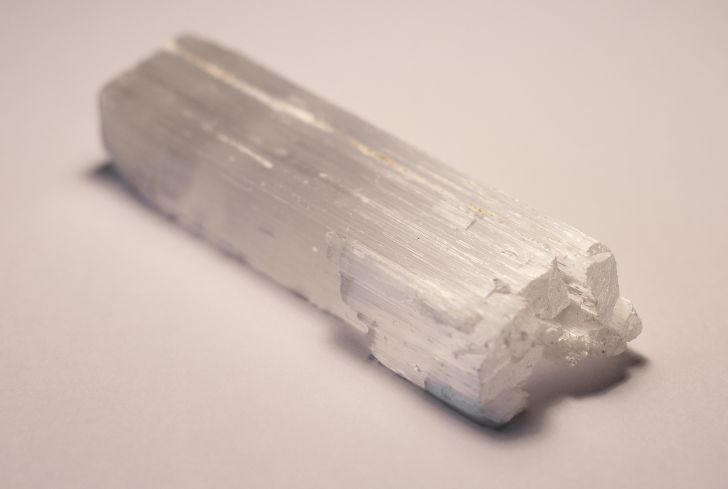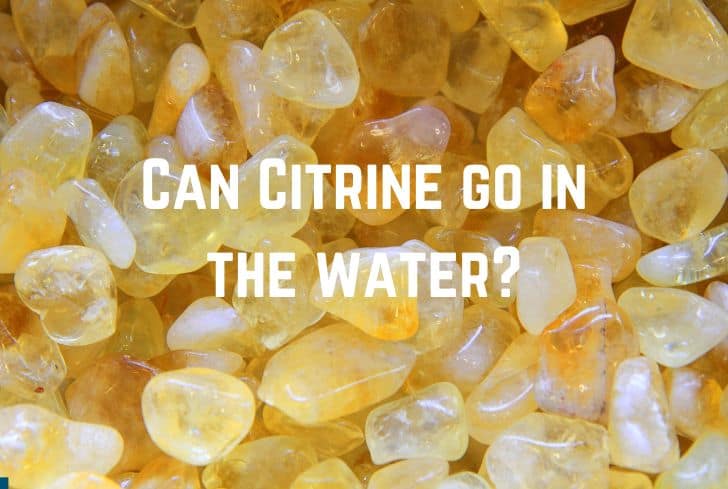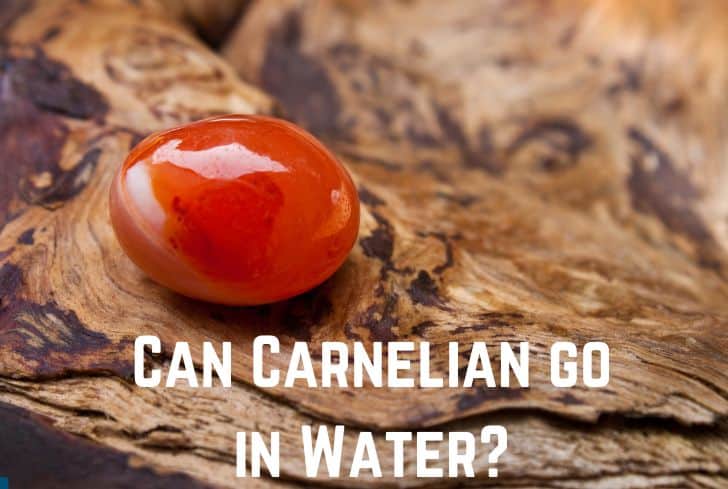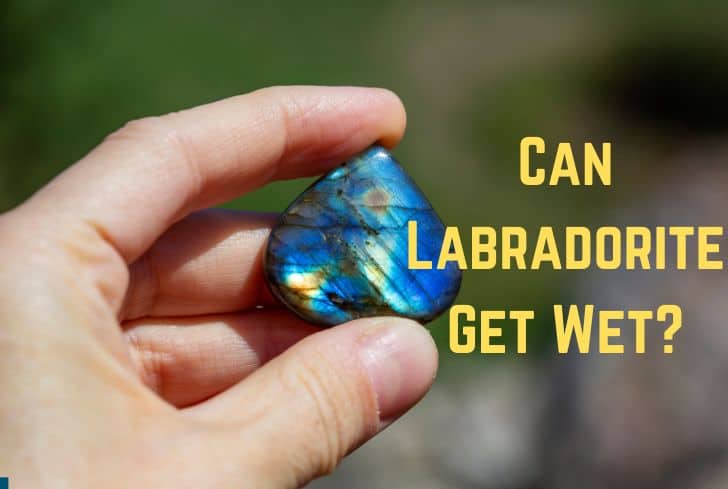Can Selenite go in Salt? (And Himalayan Salt)

Selenite is a transparent crystal habit variety of the mineral gypsum. Like all kinds of gypsum, it is made up of calcium sulfate dihydrate (having two molecules of water) and has the chemical formula CaSO4·2H2O. Its name comes from the Greek term selene meaning “moon” because people believed that the crystal waxed and waned like the moon.
Have you wondered if selenite can go in the salt? In this article, we are going to talk about just that. We will begin with the properties of selenite. Then we will discuss its interaction with salt, salt water, and fire. Finally, we will talk about cleaning and taking care of selenite.
Read: Can Rose Quartz Go in the Water
Can Selenite go in Dry Salt?
Yes, selenite can go in the salt. However, it should never be immersed in salt water. Selenite has a value of 2.0 on the Mohs Hardness Scale, meaning that it is an extremely soft mineral and will get damaged in water. When salt comes into the mix, it worsens the corrosive process. Dry salt, however, is slightly safer for selenite.
Without the help of water, salt is not able to enter the crevices of the stone. Therefore, it cannot widen their cracks and cause fissures that are damaging to the structure of the stone. Surface contact between salt and crystal is usually not harmful to the latter.
However, as mentioned, selenite is quite a soft crystal. Its hardness is so low, that it can even be scratched by a fingernail. Salt has a hardness almost equal to or greater (2.0-2.5 on the Mohs Scale) than selenite, so it does have the potential to scratch the crystal.
When you are cleansing selenite with dry salt, make sure that you handle the crystal very carefully. Do not let it rub harshly against the salt, as that can be damaging.
What are the Properties of Selenite?
These are the properties of Selenite:
- Appearance: Selenite refers to the transparent and colourless variety of gypsum crystals. This contrasts with the fibrous variety (satin spar) and the fine-grained massive forms (alabaster) of gypsum. The crystals show a subvitreous or pearly lustre, and their pale bluish reflections link them to the moon. Some selenite crystals can have opacity and color due to the presence of other minerals like druse.
- Composition: Like all kinds of gypsum, selenite is composed of calcium sulfate dihydrate, and it has the chemical formula of CaSO4·2H2O. Gypsum is a common mineral formed in sedimentary rocks when water evaporates from mineral-rich soil environments. It is deposited from lakes, seawater, and hot springs; volcanic vapors and sulfate solutions in veins also create selenite. It can also be made synthetically.
- Hardness: Selenite has a value of 2.0 on the Mohs Hardness Scale, meaning that it is an extremely soft mineral. It should not be immersed in water. Selenite is so soft that it can even be scratched with a fingernail, and therefore, it is never used in jewelry. Instead, it is used to manufacture wallboards, cement, and plaster of Paris.
- Structure: Selenite mostly occurs as tabular, prismatic, or acicular crystals, usually having no inclusions. It has a monoclinic crystal system. Twinning is common in selenite and it usually occurs in the form of “swallow tail” (two monoclinic crystals twin to form a v-shaped pattern) twins. Selenite has perfect cleavage and an uneven fracture.
- Optical Properties: Like satin spar, selenite crystals often show fluorescence (emission of light by a substance that has absorbed light) or phosphorescence. In shortwave and longwave light, selenite crystals exhibit a range of colors from blue through orangish-yellow to brown. In normal light, selenite can sometimes exhibit “hourglass” fluorescence.
Besides these, selenite is also believed to have spiritual properties. The name itself is associated with Selene, the Greek goddess and personification of the moon. The stone is said to promote peace and calm while also clearing blocked energy.
Can Selenite go in Himalayan Salt?
Yes, selenite can go in Himalayan salt. While the crystal should never be immersed in salt water because of its extremely low hardness (2.0 on the Mohs Hardness Scale), dry salt is generally much safer. Without the help of water, salt is not able to penetrate the stone or damage it.
Himalayan salt is rock salt with a pinkish tint due to the presence of trace minerals, and it is mined from the Punjab region of Pakistan. It is generally used as a food additive (often replacing refined salt) and also helps in food presentation, spa treatments, etc.
When salt is dissolved in water, it can seep into the tiny crevices of the stone, where the particles widen the cracks. These lead to fissures that are damaging to the structure of the stone. However, without the help of water, salt cannot penetrate or damage the stone.
Can Selenite go in Salt Water?
No, selenite cannot go in salt water. With a value of 2.0 on the Mohs Hardness Scale, selenite is one of the softest minerals and it will get damaged in water. When we bring salt into the mix, the corrosive effects of water are aggravated. Saltwater can tarnish the appearance and damage the structure of the stone.
In general, salt water is much more dangerous than regular water. Dissolved salt enters the crevices of stones and the particles stay there even after the water evaporates. The particles expand the cracks, damaging the structure of the stone.
Salt can also cause an adverse chemical reaction with the elements of the crystal. This is especially true for minerals containing iron, where salt hastens the rusting process by making the metal lose its electrons more easily.
When dissolved in water, salt can enter the crevices of the stone. Even after the water evaporates, these salt particles remain there and widen the cracks. These fissures may not be visible at first but can slowly damage the structure of the stone, making it brittle.
Saltwater can also tarnish the appearance of the stone by stripping off its polish. Finally, salt can also combine with the elements of the crystal and react adversely. This is especially the case when the mineral contains metal because salt water hastens the rusting process by making the metal lose its electrons more easily.
In the case of selenite, water itself is sufficient to dissolve the crystal. Saltwater only makes the process swifter.
Read: Can Hematite Go in the Water

Does Selenite Burn?
Selenite is a variety of gypsum, which is quite fire-resistant. Gypsum is used to create gypsum boards/dry walls, which are used as a finish for ceilings and interior walls. Gypsum provides a good level of fire resistance to these structures and glass fibres are further added to them to improve this property.
Selenite is a kind of gypsum, so it has very little heat conductivity. When gypsum is heated to 393K, it loses its water of crystallization and gets converted to dead burnt plaster. Check out this video by “Watch It Burn” to see what happens gypsum is burnt.
Do You Need to Cleanse and Charge Selenite?
Selenite is considered a self-cleansing stone, so cleaning it is a matter of personal choice. The stone should never be immersed in water because it has extremely low hardness and can be permanently damaged in water. Instead, you can follow other methods to clean and charge the stone.
For cleaning, you can simply wipe the stone with a soft fibre cloth. You can recharge your stone using moonlight. Simply place it at a place that gets direct moonlight or on a windowsill, and let it stay there overnight.
Read: Can Citrine go in the Water
Sunlight can be quite harmful to softer stones like selenite, but moonlight is gentle and safe. Your stone will be able to absorb the positive energies of the moon. You should leave your stone on the soil as moisture can harm it.
You can also try putting your stone on top of flowers/herbs or another cleansing stone like clear quartz or carnelian. Smudging is another method that you can try.
How to Cleanse Selenite Using salt?
Selenite has a value of 2.0 on the Mohs Hardness Scale. This means that it is an extremely soft stone and will get damaged in water. Similarly, selenite will also get damaged in salt water. However, putting selenite in dry salt is not that harmful and can be adopted as a cleansing method.
What you need to do is half-fill a glass bowl with dry salt (sea, cooking, Himalayan, etc.) and place your crystals in it. You can leave them on top of the salt or you can bury them. Leave the crystal there for a few hours or overnight.
After this, you can wipe your crystal with a soft cloth to remove all salt. The salt in the bowl should never be used as it has absorbed all the negative energies of the crystal; so simply throw it away.
However, keep in mind that selenite is a soft mineral, and even dry salt has the potential to damage the crystal. This is because salt particles have the same or greater level of hardness (2-2.5 on the Mohs Scale) as selenite. Surface contact between the two can potentially harm the crystal.
So, you have to be very careful when cleansing your selenite with dry salt. Try to ensure that the crystal does not rub harshly against the salt.
Conclusion
In this article, we have talked about selenite’s interaction with salt. Having a value of 2.0 on the Mohs Hardness Scale, selenite is an extremely soft mineral. It should never be immersed in water or salt water. Dry salt is slightly safer for selenite, and we saw how to cleanse the crystal using it. We also looked at several other methods of recharging selenite such as keeping it in the moonlight.






